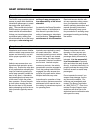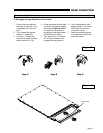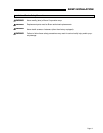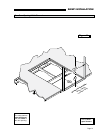
Page 14
Ramp Passenger Safety
Unless your transit agency has
a published policy stating that
driver/attendants do not aid ramp
(disabled) passengers, it is the
responsibility of the driver/at-
tendant to ensure that ramp
passengers enter and exit the
vehicle on the ramp in the saf-
est manner.
ADA requirements state that tran-
sit drivers/attendants must assist
with attaching and removing
wheelchair and occupant restraint
belts.
Ramp passengers (wheelchair
passengers and standees), and
attendants must use common
sense and good judgment regard-
ing ramp safety. Each wheelchair
passenger (or standee) has a
unique set of physical abilities
combined with the physical char-
acteristics of his or her wheelchair
(or other mobility aid) that dictate
the method in which he or she will
enter and exit the vehicle.
Wheelchair attendants should be
instructed on any special needs
and/or procedures required for
safe transport of wheelchair pas-
sengers. Follow all safety instruc-
tions regarding torso restraints,
stability, balance, weight distri-
bution and use of attendants as
specied in the owner’s manual
supplied with the passenger’s
wheelchair (or other mobility aid).
Wheelchair passengers must
determine, establish and practice
ramp boarding and exiting proce-
dures under the direction of the
their personal health care profes-
sional and wheelchair representa-
tive. Those procedures should be
conveyed to the ramp attendant.
Know your passengers abilities
and needs for optimum safety.
Attendants must never operate
the vehicle, the ramp or assist
passengers if intoxicated. In-
toxicated passengers should not
be allowed to board or exit the
vehicle.
Passengers should be positioned
in the center of the ramp at all
times. Attendants and ramp pas-
sengers must be able to clearly
view the ramp whenever boarding
and exiting the vehicle. Observe
your passengers at all times when
they are entering and exiting the
vehicle.
Wheelchair-Equipped Occupant
Seat Belts: Wheelchair passen-
gers should position and buckle
their wheelchair-equipped seat
belt (torso restraint), as specied
by the manufacturer, before load-
ing onto a wheelchair ramp.
RAMP OPERATION
W
A
RNING
Position and fasten
the wheelchair-
equipped occupant
seat belt before
loading onto the
wheelchair ramp.
Failure to do so may
result in serious
bodily injury and/or
property damage.
Different types of disabilities
require different types of wheel-
chairs and different types of
wheelchair-equipped occupant
restraint belt systems (torso re-
straint). It is the responsibility of
the wheelchair passenger to have
his or her wheelchair equipped
with an occupant restraint (seat
belt) under the direction of their
health care professional.
Stabilizing Wheelchairs: Pow-
ered and manual wheelchairs
are designed to remain upright
and stable during normal opera-
tion. All activities which involve
movement in a wheelchair have
an effect on the combined center
of gravity of the occupant and
wheelchair. Be aware of the ramp
slope (angle). The slope of the
ramp has a direct effect on the
center of gravity. The wheelchair
passenger’s center of gravity and
their ability to maintain stability
and balance must be kept in mind
by the wheelchair passenger and
the attendant.
The aid of an attendant stabilizing
the wheelchair is recommended
for optimum safety. Wheelchair
passengers who are unable to
maintain stability and balance
should not board a ramp without
assistance. Counterbalance
devices (anti-tippers) may be
available from the wheelchair rep-
resentative to enhance stability
and balance.
RA500 001.ai
W
A
RNING
Keep clear of
area in which
ramp operates.
W
A
RNING
Be aware of
ramp slope.
52217


















